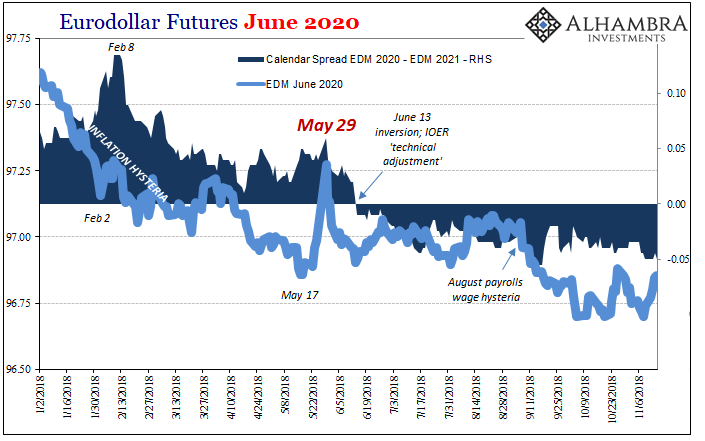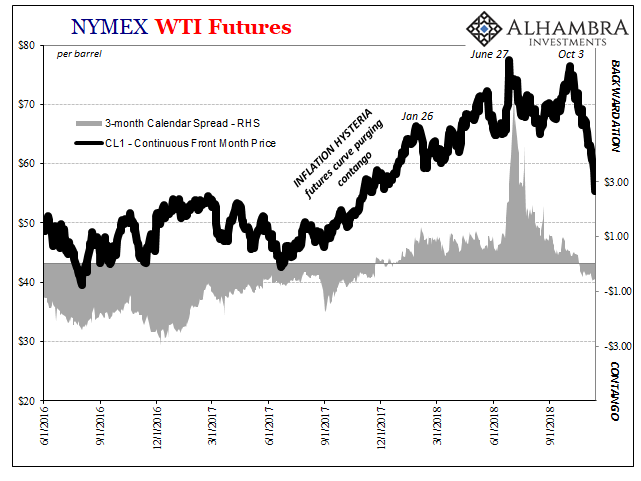The term “overseas turmoil” didn’t ever make into the official language, it was only through careful innuendo that things like FOMC meeting minutes would ever refer to the idea. It was a different story in the media, where the phrase gained its own currency. Ironically, it was the US currency behind it, which nobody could explain at the time. The most dramatic announcement to that effect came in August 2015 under Chinese authority.
Before that summer, everyone was sure the first rate hike was going to be September 2015 at the absolute latest. There had been rumors (Yellen’s six-month debacle) it would come perhaps as early as June, being six months following the expected full taper of QE’s 3 and 4.
Then CNY.
Two days after Wall Street was liquidated in a global selloff, the TV cameras were understandably pointed at Fed officials. People wanted some answers, policymakers were stunned and confused. “Overseas turmoil” seemed to fit, at least for public consumption.
It was always an odd one, though, a contradiction if you ever really thought it through. If overseas turmoil was really overseas turmoil, why would the Fed care? Why should it pause or even halt the planned monetary policy normalization in the US? When the US economy is really strong foreign problems aren’t ours.

In late August after the global liquidation wave, then-FRBNY President Bill Dudley, pre-reformed, suddenly appeared squeamish, telling reporters that a first rate hike timed for September was “less compelling to me than it was a few weeks ago.”
Wild swings in global financial markets, the slowing Chinese economy and falling commodity prices have increased the “downside risks” to the U.S. economic outlook somewhat, Dudley said in brief remarks to reporters Wednesday.
History repeats because no one was listening the first time. “Overseas turmoil” was never fully explained, never once were any of these officials made to answer for the dollar. It’s all just some market stuff over which they exercise no control, presumably.
Interesting how the quoted passage above written about three years ago eerily but accurately describes the current circumstances, this reborn overseas turmoil. Jay Powell has been an unshakable hawk. He is still a decided optimist, but there’s been a turn in his hedging all of a sudden. Speaking in Dallas this week, the FOMC Chairman conceded, “growing signs of a bit of a slowdown for 2018.”
Mario Draghi, he is not.
That’s how all these things go, starting in 2007. The economy is always strong when they want it to be, and if it isn’t it is because of something far off in the distance way beyond their reach. It’s an unproductive contribution to economy and honest discourse from these supposedly best and brightest.
This “heads I win, tail you lose” philosophy is as old as the Federal Reserve. Milton Friedman wrote more than a half century ago about this phenomenon appearing in the twenties just in time for thirties:
It is natural human tendency to take credit for good outcomes and seek to avoid the blame for bad. One amusing dividend from reading through the annual reports of the Federal Reserve Board seriatim is the sharpness of the cyclical pattern in the potency attributed to the System. In years of prosperity, monetary policy is said to be a potent instrument, the skillful handling of which deserves credit for the favorable course of events; in years of adversity, monetary policy is said to have little leeway but is largely the consequence of other forces, and it was only the skillful handling of the exceedingly limited powers available that prevented conditions from being even worse. [emphasis added]
Thus, it was somewhat funny to see one of the headlines in Bloomberg: Fed Rate Pause Possible in 2019 as Powell Highlights Headwinds.
Fed chief cites slowing global demand, fading fiscal stimulus.
Powell remains totally optimistic, and he doesn’t really believe that such downside is possible. It’s not that he wants to say these things and admit that there are very visible problems in the global economy right now; especially after what was said last year. He has to recognize reality even if it is just headwinds, one possible scenario, or overseas turmoil.
Where have you gone globally synchronized growth? What happened to decoupling? If Jay Powell out of anyone on Earth is talking about economic risks in this context, they must be a lot more than people appreciate. Central bankers are always, always the last to know.
Like 2015, these things stay synchronized. As I’ve written before:
From 2003 to 2009, it went: globally synchronized growth, decoupling, globally synchronized downturn. From 2010 to 2012, it went: globally synchronized growth, decoupling, globally synchronized downturn. From 2013 to 2016, it went: strong global growth (not synchronized), decoupling, synchronized downturn.
Last year to this year, it has gone: globally synchronized growth, decoupling. What comes next?
Whatever does come next, the headwinds flapping against the Chairman’s skull are a sign it’s already started. They really don’t know what they are doing.



Stay In Touch